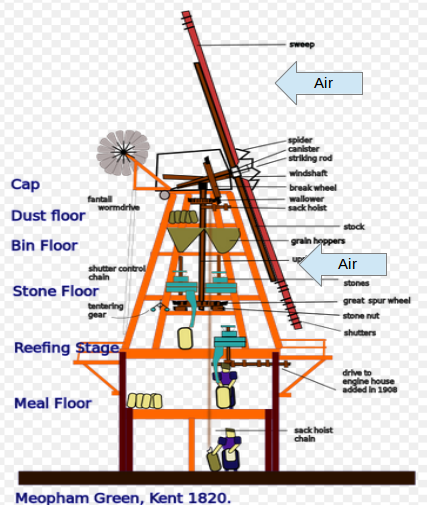Wind energy is a renewable energy source obtained from nature and is converted to either electrical energy or mechanical energy depending on the need and is one of the fastest growing renewable energy resources.
Many will amazed to hear wind energy is a form of solar energy. Winds are generated by temperatures differences/gradients between land and sea.
How Do Windmills Work?
A windmill converts wind energy (kinetic energy) into rotational energy through a set of vanes similar to sails as shown in image.

Image source: Wiki
Usually 4 or more sails are required to generate more power as mechanical work is largely done using this type of energy generation and hence causing more rotations.
Windmills are now more of a scenic beauty than a power generating machine since these towers are are mostly on the hills and has a natural scenic attraction towards them.
Windmill primarily gets its name for milling grains for the purpose of food production and other agricultural needs such as pumping water, extracting groundwater and this is not a new invention in place. This has been in practice for years and years dating back to 1st century (AD).
Classifications of windmills:
Windmills are primarily classified into two categories
1.Horizontal axis windmills
2.Vertical axis windmills
Wind Turbines vs Windmills
Wind trubine is an extension or advancement of windmill with proper equipments to facilitate electricity generation. In simple terms, wind turbines convert wind energy into electrical energy. It uses a charging unit to produce the necessary electricity.
Wind mills and wind turbines are not same but similar. The latter being the more efficient of the two because of its advancement. Usually horizontal axis turbines are used whereas vertical axis turbines are not used because of their lower overhead heights.
Working of Wind Turbines:
A wind turbine system comprises as follows.
1.Blade/Rotor
2.Drive-train comprising of gearbox and generator inside ‘Nacelle’
3.Tower
4.Yaw drive, wind vane and anemometer and other electrical connections, cables, ground support.

A modern wind turbine harnesses energy from the wind using three or more blades similar to that of aeroplane propeller.
The blades are connected to a main shaft (gear with more teeth) which is connected to another shaft (gear with lesser teeth) and thus power is transmitted.
Gearbox-generator unit is placed inside a unit called ‘nacelle’, meaning housing/shell. This gearbox is coupled to a AC generator which is usually an induction generator.
The speed of the shaft connected to blades will be in the range of 25-60 rpm. Apart from the regular arrangement, it has anemometer which measures the wind speed and transmits speed data to the computer device controller.
A yaw drive is used to keep the blades facing the wind.
The kinetic energy of wind is converted to rotational energy of rotor.
The rotor runs the generator which produces electricity.
To sum up non-conventional / renewable energy resources require high capital cost in comparison with conventional energy resources. But, cleaner energy is the need of the hour for our future generations to survive.
